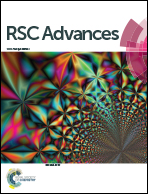Chiral and achiral copper(ii) complexes: structure, bonding and biological activities†
Abstract
Three novel layered inorganic–organic hybrids [S-(C8H12N)2][CuCl4] (1), [R-(C8H12N)2][CuCl4] (2) and an achiral phase obtained from the racemic solution, namely (C8H12N)2[CuCl4] (3) were synthesized under hydrothermal conditions and characterized by various physicochemical techniques. Compounds 1 and 2 were synthesized through the use of copper chloride as the inorganic motif and enantiomorphically pure sources of either (S)-α-methylbenzylamine or (R)-α-methylbenzylamine. They crystallize in the polar chiral space group C2 (no. 5). Compound 3 crystallizes in the polar achiral space group C2cb (no. 41). The supramolecular crystal structure of these materials is built from alternatively arranged inorganic and organic layers and stabilized by N–H⋯Cl hydrogen bonds between the inorganic and organic moieties and C–H⋯π interactions between the aromatic rings of the organic moieties themselves. All these non-covalent interactions, which bind the supramolecular aggregate, were illustrated using the non-covalent interaction (NCI) plot technique. The synthesized products were also screened for in vitro antioxidant and antimicrobial activities, while showing favorable antioxidant activities against DPPH as well as the discoloration of β-carotene. Moreover, it is worth noting that copper complexes exhibit high antihypertensive activity against the inhibition of angiotensin I-converting enzyme (ACE) by dietary anti-hypertensive agents.


 Please wait while we load your content...
Please wait while we load your content...